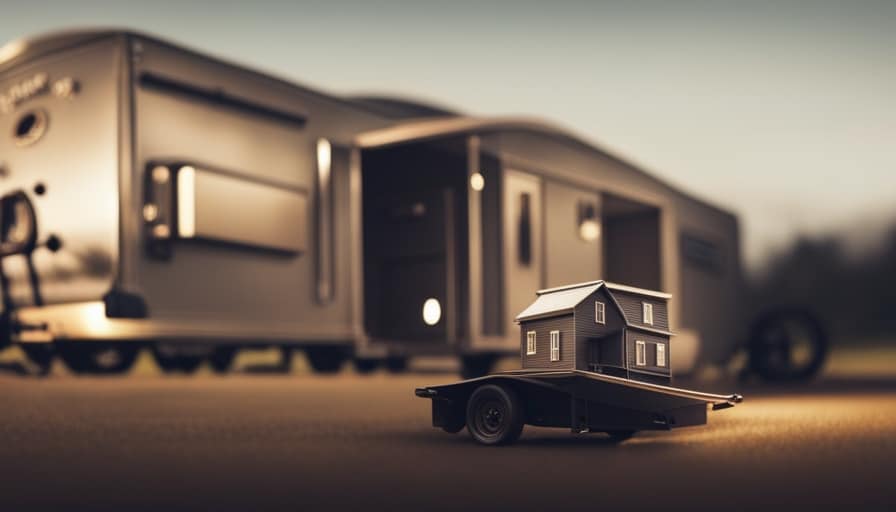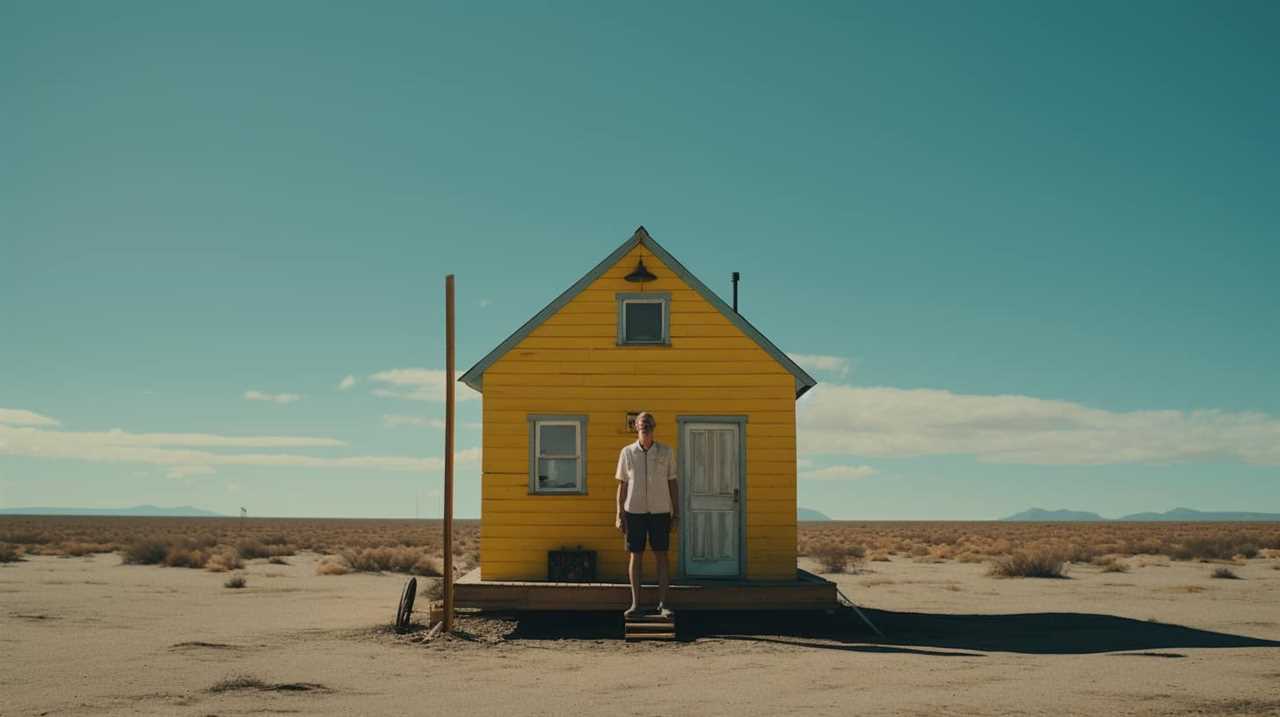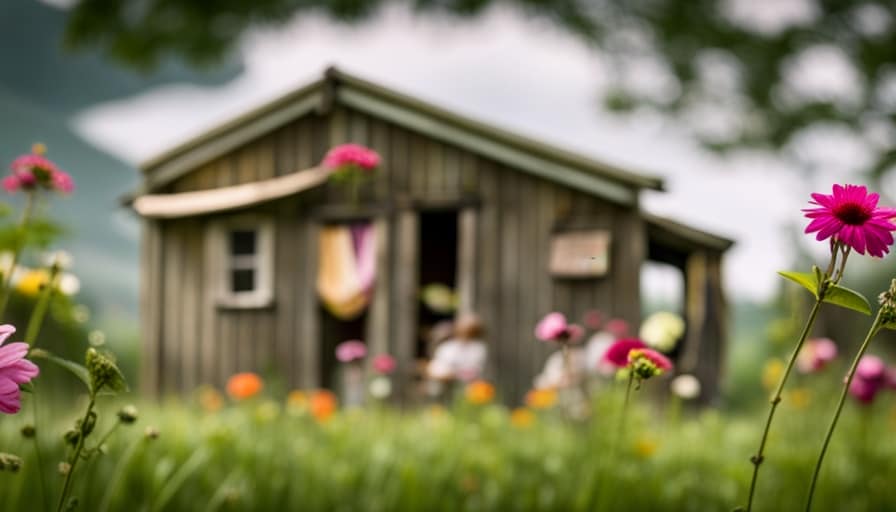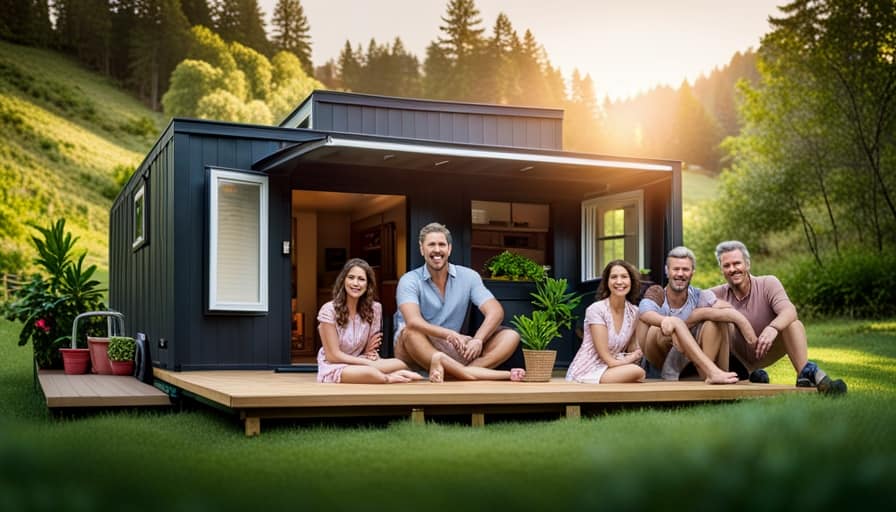Being a fan of tiny houses, I have frequently pondered about the legality of placing my ideal home on a plot of land. Luckily, there are ways to navigate through zoning and building regulations.
By researching local laws, obtaining permits, and meeting size requirements, we can ensure a smooth and lawful process.
In this article, we’ll explore these steps and alternative options for placing our tiny houses, so we can live our dreams while abiding by the law.
Key Takeaways
- Research local zoning regulations and building codes to understand the requirements for placing a tiny house on a piece of land legally.
- Identify the zoning category of the land and determine the specific requirements and permits needed for tiny houses.
- Obtain necessary permits and approvals by following the local regulations and considering the environmental impact and financial costs.
- Ensure that the tiny house meets the minimum size requirements specified by the building codes, and consider exemptions and variance processes if applicable.
Understanding Zoning and Building Regulations
As I begin to navigate the process of putting my tiny house on a piece of land legally, I must first understand zoning and building regulations. Understanding variances and exceptions is crucial in ensuring that my tiny house complies with the rules set by local authorities.

Zoning regulations dictate how land can be used and what can be built on it, while building regulations outline the specific requirements for construction. It’s important to research and understand these regulations to avoid any legal issues or penalties.
Navigating HOA restrictions is also important, as some neighborhoods may have additional rules and guidelines that must be followed. By familiarizing myself with these zoning and building regulations, as well as any HOA restrictions, I can ensure that my tiny house is placed on the land legally and without any complications.
Researching Local Laws and Ordinances
Before starting the process of putting my tiny house on a piece of land legally, I need to research local laws and ordinances to ensure compliance. Finding suitable land is the first step, but navigating legal restrictions is equally important. Local laws and ordinances vary from place to place, so it’s crucial to understand the specific regulations in the area where I plan to place my tiny house. To help you understand the process better, here is a table outlining some key factors to consider when researching local laws and ordinances:
| Factor to consider | Questions to ask | Resources to consult |
|---|---|---|
| Zoning regulations | What zoning category does the land fall under? | Local planning department |
| Building codes | What are the specific requirements for tiny houses? | Local building department |
| Permitting process | What permits are required for placing a tiny house on the land? | Local building department |
| Setback requirements | How far must the tiny house be from property lines and other structures? | Local zoning codes |
Obtaining Permits and Approvals
To successfully put my tiny house on a piece of land legally, I’ll need to obtain the necessary permits and approvals. This process involves several steps and considerations:

-
Research local regulations: Understand the specific requirements and restrictions for placing a tiny house on the chosen land. This includes zoning laws, building codes, and any special regulations related to tiny houses.
-
Environmental impact: Evaluate the potential impact of the tiny house on the surrounding environment. This may involve considerations such as waste management, water usage, and renewable energy sources.
-
Financial considerations: Determine the costs associated with obtaining permits and approvals. This may include application fees, inspections, and potential modifications to meet code requirements.
Meeting Minimum Size Requirements
I can meet the minimum size requirements by ensuring that my tiny house meets the specified dimensions outlined by the local regulations. It’s essential to thoroughly research and understand the building code exemptions and variance process in my area. These regulations may provide flexibility for tiny houses, allowing for smaller square footage than traditional homes.

Building code exemptions could include relaxed requirements for ceiling height, bathroom size, or stair dimensions. In some cases, I may also be able to apply for a variance, which would grant me permission to deviate from the minimum size requirements. By familiarizing myself with these options and working closely with local authorities, I can ensure that my tiny house meets all necessary regulations while still maintaining the unique characteristics that make it a tiny home.
Now, let’s explore alternative options for tiny house placement.
Exploring Alternative Options for Tiny House Placement
How can I legally explore alternative options for placing my tiny house on a piece of land? When it comes to finding the perfect spot for your tiny house, it’s important to consider land availability and off-grid living options. Here are three alternative options to explore:
-
Community Living: Joining a tiny house community can provide you with a legal and supportive environment. These communities often have designated spaces for tiny houses, ensuring you can live legally and enjoy the benefits of a like-minded community.

-
Renting Land: Another option is to rent a piece of land from a private landowner. This allows you to have your tiny house on someone else’s property while following all legal requirements. Make sure to have a clear rental agreement in place to protect both parties.
-
Mobile Living: Consider embracing the freedom of living on wheels. By keeping your tiny house mobile, you can explore different areas and stay within legal boundaries. Just make sure to research zoning laws and regulations in each location you plan to stay.
Exploring these alternative options can help you find a legal and suitable place to park your tiny house while enjoying the benefits of off-grid living.
Frequently Asked Questions
Can I Legally Live in a Tiny House Full-Time on My Own Land?
Yes, I can legally live in a tiny house full-time on my own land. However, it is crucial to ensure that I comply with local zoning regulations, obtain necessary permits, and consider factors such as tiny house insurance and financing options.

Are There Any Restrictions on the Size or Height of a Tiny House That I Can Place on a Piece of Land?
Are there any size or height restrictions on placing a tiny house on a piece of land? It’s important to be aware of any local zoning regulations that may limit the dimensions of your tiny house.
Do I Need to Connect My Tiny House to Utilities Such as Water, Sewer, and Electricity?
I need to connect my tiny house to utilities such as water, sewer, and electricity. It’s important to consider if I want to live off-grid or if I prefer the convenience of being connected to these services.
Are There Any Specific Design or Construction Standards That I Need to Follow When Building a Tiny House?
When building a tiny house, it’s important to consider design flexibility and use eco-friendly materials. Meeting construction standards ensures safety and compliance with regulations. Proper planning and research are key to a successful project.
Can I Place a Tiny House on a Piece of Land That Is Zoned for Agricultural or Commercial Use?
I can place a tiny house on agricultural land if it meets zoning requirements. For commercial property, I need to obtain permits and follow regulations specific to placing a tiny house.

Conclusion
In conclusion, putting a tiny house on a piece of land legally requires understanding zoning and building regulations, researching local laws and ordinances, obtaining permits and approvals, and meeting minimum size requirements.
One interesting statistic to note is that according to a survey conducted by the Tiny House Association, 68% of tiny house owners faced zoning and regulatory challenges when trying to find a legal place to park their homes.
It’s essential to thoroughly research and comply with local regulations to ensure a smooth and legal process.
I’m Theodore, and I love tiny houses. In fact, I’m the author of Tiny House 43, a book about tiny houses that are also tree houses. I think they’re magical places where imaginations can run wild and adventures are just waiting to happen.
While tree houses are often associated with childhood, they can be the perfect adult retreat. They offer a cozy space to relax and unwind, surrounded by nature. And since they’re typically built on stilts or raised platforms, they offer stunning views that traditional homes simply can’t match.
If you’re looking for a unique and romantic getaway, a tree house tiny house might just be the perfect option.










